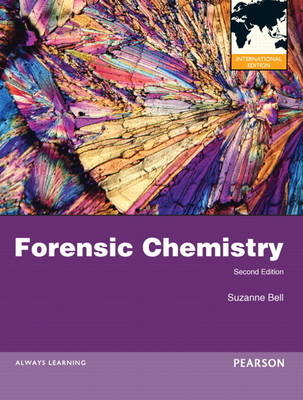
Forensic Chemistry
Pearson (Verlag)
978-0-321-81687-0 (ISBN)
- Titel erscheint in neuer Auflage
- Artikel merken
Chapter 1- Introduction and Overview- Chemistry and the Law
1.1 What is Forensic Chemistry?
1.2 Precedent in Chemistry and the Law
1.3 Key Forensic and Legal Concepts
1.4 The Flow of a Forensic Analysis
1.5 The Forensic Mind-Set
1.6 Forensic Chemistry Today
1.7 Becoming and Being a Forensic Professional
PART 1- METROLOGY
Chapter 2- Foundations
2.1 Metrology and Measurement
2.2 Significant Figures, Rounding, and Uncertainty
2.3 Fundamental Statistics
2.4 Error, Accuracy, and Precision
2.5 Hypothesis Testing
Chapter 3- Quality Assurance and Quality Control
3.1 Quality Assurance and Quality Control
3.2 Quality Control Procedures
3.3 Quality Control and Calibration
Chapter 4- Reporting Defensible Uncertainty and Obtaining Representative Samples
4.1 Uncertainty
4.2 Sampling and Sampling Plans
PART 2- CHEMICAL FOUNDATIONS
Chapter 5- Chemical Fundamentals: Partitioning, Equilibria, and Acid/ Base Chemistry
5.1 General Considerations
5.2 An Introductory Example
5.3 The Special K’s
5.4 Partitioning
5.5 Partitioning with a Solid Phase
5.6 Extension of Partitioning: Thin-Layer Chromatography
Chapter 6- Instrumentation
6.1 Microscopes and Chemical Microscopy
6.2 Spectroscopy
6.3 Mass Spectroscopy
6.4 Elemental Analysis
6.5 Microspectrophotometry
6.6 Electrophoretic Instrumentation
PART 3- DRUGS AND POISON
Chapter 7- Drugs as Physical Evidence: Seized Drugs and Their Analysis
7.1 What is a Drug?
7.2 Classification and Categories
7.3 Drugs as Evidence
7.4 Analysis of Seized Drugs
Chapter 8- Forensic Drug Analysis II: Selected Drug Classes
8.1 Acidic and Neutral Drugs
8.2 Basic Drugs
Chapter 9- Drugs in the Body
9.1 Introduction
9.2 ADME
9.3 Compartment Models
9.4 Absorption
9.5 Metabolism
9.6 Elimination
9.7 An Integrated Approach
9.8 Dosage Considerations
9.9 How Drugs Work
Chapter 10- Forensic Toxicology
10.1 Sample Types
10.2 Categories of Forensic Toxicology
10.3 Analytical Methods
PART 4 COMBUSTION EVIDENCE
Chapter 11- The Chemistry of Combustion and Arson
11.1 The Combustion Continuum
11.2 Aspects of Combustion
11.3 Flames and Fires
11.4 Arson and Fire Investigation
Chapter 12- Explosives
12.1 Explosions, Detonations, and Explosives
12.2 Explosive Power
12.3 Forensic Analysis of Explosives
Chapter 13- Firearms and Associated Chemical Evidence
13.1 How Guns Work
13.2 Primers and Propellants
13.3 Forensic Chemical Analysis of Firearms Evidence
13.4 Serial Number Restoration
PART 5 MATERIALS
Chapter 14- The Chemistry of Colors and Colorants
14.1 Color: A Quantitative View
14.2 Colorants
14.3 Application of Colorants: Inks
14.4 Applications of Colorants: Mechanical and Computer Printing
14.5 Applications of Colorants: Paint
Chapter 15- The Chemistry of Polymers
15.1 Polymers
15.2 Biopolymers: Polysaccharides
15.3 Synthetic Polymers
Chapter 16- Forensic Analysis of Inks and Paints
16.1 Analytical Methods
16.2 Aging and Dating
Chapter 17- Chemical Analysis of Materials I: Paper, Fibers, and Plastic
17.1 Analysis of Materials: An Overview
17.2 Analysis of Paper
17.3 Fibers
Appendix 1- Alphabetical Glossary of Terms
Appendix 2- Abbreviations
Appendix 3- Solvent Properties for SPE and HPLC
Appendix 4- Key Organic Chemistry Terms and Reactions
Appendix 5- Thermodynamic Quantities
Appendix 6- Apothecary and Other Units in Forensic Chemistry
Appendix 7- Characteristic Infrared Group Frequencies
Appendix 8- Reagents for Color Test Reagents
Appendix 9- Tables for Statistical Testing
| Erscheint lt. Verlag | 8.2.2012 |
|---|---|
| Sprache | englisch |
| Maße | 203 x 249 mm |
| Gewicht | 928 g |
| Themenwelt | Recht / Steuern ► Strafrecht ► Kriminologie |
| ISBN-10 | 0-321-81687-0 / 0321816870 |
| ISBN-13 | 978-0-321-81687-0 / 9780321816870 |
| Zustand | Neuware |
| Haben Sie eine Frage zum Produkt? |
aus dem Bereich



